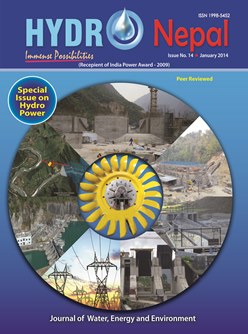Norwegian Design Principle for High Pressure Tunnels and Shafts: Its Applicability in the Himalaya
DOI:
https://doi.org/10.3126/hn.v14i0.11254Keywords:
Tunneling, Himalayan geology, Norwegian design principles, Hydropower, NepalAbstract
Cost effective, safe and long term sustainable hydropower development is key for the lasting economic growth in the Himalayan region. Increasing pressure towards the use of renewal and environmentally friendly energy for industrial growth and daily household use will force the Himalayan region to exploit hydropower energy more extensively. The traditionally used design approach of fully lined underground waterway system is costly and financially unfeasible as well as an obstacle to attract investment in the hydropower sector in the Himalaya. Hence, more innovative solutions are needed to make hydro generated energy more cost effective and as a sustainable energy solution in the long term. This paper briefly describes the geological set-up of Scandinavia, history of Norwegian Hydropower and reviews the design principle used to develop the underground waterway system in Norway. Brief comments are also made on the applicability of these principles in the Himalayan region. It is anticipated that more discussions will be made in the future on the geo-tectonic environment of the Himalaya and suitability of Norwegian design principle in the Himalayan region.
DOI: http://dx.doi.org/10.3126/hn.v14i0.11254
HYDRO Nepal Journal
Journal of Water, Energy and Environment
Volume: 14, 2014 January
Page: 36-40
Downloads
Downloads
Published
How to Cite
Issue
Section
License
The copyright of the articles and papers published is held by HYDRO Nepal Journal.
The views and interpretation in this journal are those of author(s), and HYDRO Nepal does not bear any responsibility for the views expressed by authors in the journal.




